
In ancient Roman religion and myth, Faunus[ˈfau̯nʊs] was the horned god of the forest, plains and fields; when he made cattle fertile he was called Inuus. He came to be equated in literature with the Greek god Pan.

Vǫluspá is the best known poem of the Poetic Edda. It tells the story of the creation of the world and its coming end and subsequent rebirth, related to the audience by a völva addressing Odin. It is one of the most important primary sources for the study of Norse mythology. The poem is preserved whole in the Codex Regius and Hauksbók manuscripts while parts of it are quoted in the Prose Edda.

Tivoli is a town and comune in Lazio, central Italy, 30 kilometres north-east of Rome, at the falls of the Aniene river where it issues from the Sabine hills. The city offers a wide view over the Roman Campagna.
The sibyls were prophetesses or oracles in Ancient Greece. The sibyls prophesied at holy sites. A sibyl at Delphi has been dated to as early as the eleventh century BC by Pausanias when he described local traditions in his writings from the second century AD. At first, there appears to have been only a single sibyl. By the fourth century BC, there appear to have been at least three more, Phrygian, Erythraean, and Hellespontine. By the first century BC, there were at least ten sibyls, located in Greece, Italy, the Levant, and Asia Minor.

The Sibylline Oracles are a collection of oracular utterances written in Greek hexameters ascribed to the Sibyls, prophetesses who uttered divine revelations in a frenzied state. Fourteen books and eight fragments of Sibylline Oracles survive, in an edition of the 6th or 7th century AD. They are not to be confused with the original Sibylline Books of the ancient Etruscans and Romans which were burned by order of the Roman general Flavius Stilicho in the 4th century AD. Instead, the text is an "odd pastiche" of Hellenistic and Roman mythology interspersed with Jewish, Gnostic and early Christian legend.
The Mirabilis liber is an anonymous and formerly very popular compilation of predictions by various Christian saints and divines that was partially written in the Middle Ages, around the year 1000, received additions and first printed in France in 1522 and reprinted several times thereafter. It is not to be confused with the almost contemporary Liber mirabilis. Its unwitting contributors include:

The Villa d'Este is a 16th-century villa in Tivoli, near Rome, famous for its terraced hillside Italian Renaissance garden and especially for its profusion of fountains. It is now an Italian state museum, and is listed as a UNESCO World Heritage Site.

The Sibylline Books were a collection of oracular utterances, set out in Greek hexameters, that, according to tradition, were purchased from a sibyl by the last king of Rome, Tarquinius Superbus, and were consulted at momentous crises through the history of the Republic and the Empire. Only fragments have survived, the rest being lost or deliberately destroyed.

The Delphic Sibyl was a woman who was a prophet associated with early religious practices in Ancient Greece and is said to have been venerated from before the Trojan Wars as an important oracle. At that time Delphi was a place of worship for Gaia, the mother goddess connected with fertility rituals that are thought to have existed throughout the ancient Mediterranean world. As needed to maintain the religious tradition, the role of sibyl would pass to another priestess at each site.

The Persian Sibyl - also known as the Babylonian, Chaldaean, Hebrew or Egyptian Sibyl - was the prophetic priestess presiding over the Apollonian oracle.

Written in Syriac in the late seventh century, the Apocalypse of Pseudo-Methodius shaped and influenced Christian eschatological thinking in the Middle Ages. Falsely attributed to Methodius of Olympus, a fourth century Church Father, the work attempts to make sense of the Islamic conquest of the Near East. The Apocalypse is noted for incorporating numerous aspects of Christian eschatology such as the invasion of Gog and Magog, the rise of the Antichrist, and the tribulations that precede the end of the world.

Adso of Montier-en-Der was abbot of the Benedictine monastery of Montier-en-Der in France, and died on a pilgrimage to Jerusalem. Biographical information on Adso comes mainly from one single source and has come under question, but the traditional biography depicts him as an abbot who enacted important monastic reform, as a scholar, and as a writer of five hagiographies. His best-known work was a biography of Antichrist, titled "De ortu et tempore Antichristi", which combined exegetical and Sibylline lore. This letter became one of the best-known medieval descriptions of Antichrist, copied many times and of great influence on all later apocalyptic tradition, in part because, rather than as an exegesis of apocalyptic texts, he chose to describe Antichrist in the style of a hagiography.

Symphorosa is venerated as a saint of the Catholic Church. According to tradition, she was martyred with her seven sons at Tibur toward the end of the reign of the Roman Emperor Hadrian (117–38).

The Temple of Vesta is a Roman temple in Tivoli, Italy, dating to the early 1st century BC. Its ruins sit on the acropolis of the city, overlooking the falls of the Aniene that are now included in the Villa Gregoriana.
Last Roman Emperor, also called Last World Emperor or Emperor of the Last Days, is a figure of medieval European legend, which developed as an aspect of Christian eschatology. The legend predicts that in the end times, a last emperor would appear on earth to reestablish the Roman Empire and assume his function as biblical katechon who stalls the coming of the Antichrist. The legend first appears in the 7th-century apocalyptic text known as the Apocalypse of Pseudo-Methodius; that and the oracles of the Tiburtine Sibyl are its two most important sources. It developed over the centuries, becoming particularly prominent in the 15th century. The notion of Great Catholic Monarch is related to it.

In Christian eschatology, the Antichrist or anti-Christ refers to people prophesied by the Bible to oppose Jesus Christ and substitute themselves in Christ's place before the Second Coming. The term Antichrist is found five times in the New Testament, solely in the First and Second Epistle of John. The Antichrist is announced as the one "who denies the Father and the Son."

The Cumaean Sibyl was the priestess presiding over the Apollonian oracle at Cumae, a Greek colony located near Naples, Italy. The word sibyl comes from the ancient Greek word sibylla, meaning prophetess. There were many sibyls in different locations throughout the ancient world. Because of the importance of the Cumaean Sibyl in the legends of early Rome as codified in Virgil's Aeneid VI, and because of her proximity to Rome, the Cumaean Sibyl became the most famous among the Romans. The Erythraean Sibyl from modern-day Turkey was famed among Greeks, as was the oldest Hellenic oracle, the Sibyl of Dodona, possibly dating to the second millennium BC according to Herodotus, favored in the east.
The concept of the Antichrist has been a vigorous one throughout Christian history, and there are many references to it and to associated concepts both in the Bible and in subsequent ecclesiastical writings.

Eclogue 4, also known as the Fourth Eclogue, is the name of a Latin poem by the Roman poet Virgil. Part of his first major work, the Eclogues, the piece was written around 40 BC, during a time of brief stability following the Treaty of Brundisium; it was later published in and around the years 39–38 BC. The work describes the birth of a boy, a supposed savior, who once of age will become divine and eventually rule over the world. During late antiquity and the Middle Ages, a desire emerged to view Virgil as a virtuous pagan, and as such, early Christians, such as Roman Emperor Constantine, early Christian theologian Lactantius, and St. Augustine—to varying degrees—reinterpreted the poem to be about the birth of Jesus Christ.

The Arabic Sibylline prophecy is a set of Christian apocalyptic texts based on the tradition of the Tiburtine Sibyl. The original version of the prophecy was probably composed in the late 8th century by Melkites in ʿAbbāsid Syria. It is an example of vaticinia ex eventu and was composed "to give encouragement and hope to Christians living under Islamic rule, especially during periods of political instability." The prophecy is possibly the oldest apocalyptic text composed in Arabic.



























